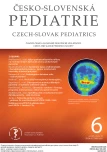Specifics of care for tracheostomized pediatric patients – relevant topic
Authors:
M. Bodláková; M. Jurovčík; L. Gernertová; J. Skřivan
Authors‘ workplace:
Klinika ušní, nosní a krční 2. LF UK a FN Motol, Praha
Published in:
Čes-slov Pediat 2021; 76 (6): 345-349.
Category:
Review
Overview
We have observed material differences in the quality of care of tracheostomized patients, with the process often being incomplete or insufficient in scope. The level of care afforded to trachestomized children and adults differs notably. The main differences are found in fundamental procedures including the surgical method, the use of suitable type of tracheostomy tube, the frequency of replacement of tracheostomy tube and the training of parents. The care of tracheostomized child should be known multidisciplinary, mainly by anesthetists, pediatricians, neurologists, rehabilitation specialists. Between 2014–2020 138 tracheostomies were made on pediatric patients. Separately we have gained experience with other tracheostomized patients from other hospitals. We find an inappropriate level of education in how to care for tracheostomized children as extremely important given the high risk of suffocation, caused by obstruction or dislodgement of tracheostomy tube. In this article we provide specific details on how to improve the care for tracheostomized pediatric patients.
Keywords:
care – tracheostomy tube – pediatric tracheostomy
Sources
1. Chrobok V, Astl J, Komínek P, a kol. Tracheostomie a koniotomie, techniky, komplikace a ošetřovatelská péče. Praha: Maxdorf, 2004: 16–21. ISBN 80-7345-031-3.
2. Daudia A, Gibbin KP. Management of tracheostomy. Current Pediatrics 2006; 16 (4): 225–229.
3. Bodláková M, Jurovčík M, Katra R, et al. Stridor kongenitálního původu. Otorinolaryng a Foniat (Prague) 2019; 68 (1): 30–35.
4. Fraga JC, et al. Pediatric tracheostomy. J Pediatr (Rio J) 2009; 85 (2): 97–103. doi: 10.2223/JPED.1850.
5. Jurovčík M. Otorinolaryngologie. In: Marková D, Chvílová Weberová M. Předčasně narozené dítě. Následná péče – kdy začíná a kdy končí? Praha: Grada, 2020: 281–290. ISBN 978-80- 271-1745-1.
6. Fradis M, Malatskey S, Dor I, et al. Early complications of tracheostomy performed in the operating room. J Otolaryngol 2003; 32 (1): 55–57.
7. Jurovčík M, Bodláková M, Gernertová L, Skřivan J. Tracheostomie u dětí, odpovídající péče jako základ minimalizace rizik. Pediatr praxi 2021; 22 (1): 15–19.
8. Jurovčík M. Péče o dítě s tracheostomií. In: Pohůnek P, Koťátko P, Tuková J.: Dětská pneumologie. Praha: Mladá fronta a. s., 2018: 599–610.
9. Woodgate PG, Flenady V. Tracheal suctioning without disconnection in intubated ventilated neonates. Cochrane Database Syst Rev 2001; 2: CD003065. doi: 10.1002/14651858. CD003065.
10. Main E, Castle R, Newham D, Stocks J. Respiratory physiotherapy vs suction: the effects on respiratory function in ventilated infants and children. Intensive Care Med 2004; 30 (6): 1144–1151.
11. Pattie S, Twomey B. Clinical Guidelines: Endotracheal Tube Suction of Ventilated Neonates. Melbourne: The Royal Childrens Hospital, 2012. http://www.rch.org.au/rchcpg/hospital-clinical-guideline index/Endotracheal-Tube Suction-of-Ventilated- Neonates/.
12. Clinical Guidelines: Suction, 2009. http://www.gosh.nhs.uk/ health-professionals/clinical-guidelines/suction.
13. Posner JC. Replacing a tracheostomy tube. In: Baren J, et al. Pediatric Emergency Medicine. Elsevier, 2008: 1173–1176.
14. Sherman JM, Davis S, Albamonte-Petrick S, et al. Care of the child with a chronic tracheostomy. Am J Respir Crit Care Med 2000 Jan; 161 (1): 297–308.
15. Becker E, et al. Mechanical ventilation in children. Chest 1988; 93: 333–335.
16. Jarrett WA, Ribes J, Manaligod JM. Biofilm formation on tracheostomy tubes. Ear Nose Throat J 2002; 81 (9):659–661.
17. Kumarasinghe D, Wong EH, Duvnjak M, et al. Colonization rates of tracheostomy tubes associated with the frequency of tube changes. ANZ J Surg 2020; 90 (11): 2310–2314.
18. Yaremchuk K. Regular tracheostomy tube changes to prevent formation of granulation tissue. Laryngoscope 2003; 113 (1): 1–10.
Labels
Neonatology Paediatrics General practitioner for children and adolescentsArticle was published in
Czech-Slovak Pediatrics

2021 Issue 6
Most read in this issue
- Not every hemangioma is a hemangioma...
- Edwards syndrome – phenotype, prognosis, ethical attitudes, professional and palliative care
- Systemic lupus erythematosus with hematological symptoms – a multifaceted disease: case reports and summary for clinical practice
- Effect of gastroesophageal reflux on cilia in upper respiratory tract in children
